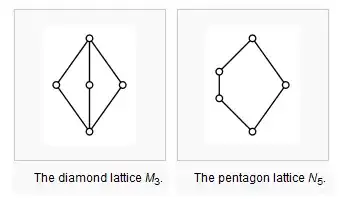In thinking about this recent question, I was reading about distributive lattices, and the Wikipedia article includes a very interesting characterization:
A lattice is distributive if and only if none of its sublattices is isomorphic to $M_3$ or $N_5$.
where
$\hskip 1.7in$ 
As the answers to the other question demonstrate, it is pretty easy to construct examples of rings with non-distributive ideal lattices; for example, any Noetherian domain either having Krull dimension $>1$, or being non-integrally closed, has a non-distributive ideal lattice. For example, true to the above characterization, the lattice of ideals of $k[x,y]$ has an $M_3$ sublattice: $$(x,y)$$ $$\text{ / }\qquad |\qquad \text{ \ }$$ $$\quad\quad(x)\quad\quad(y)\,\,\,\,\quad (x+y)$$ $$\text{ \ } \qquad |\qquad \text{ / }$$ $$(0)$$ Of course, it has many other such sublattices, and even in the above example, there are other ideals like $(x+2y)$, $(x^2)$, etc. that live between $(0)$ and $(x,y)$, that we have thrown out for the purposes of getting our $M_3$ sublattice. What I would like to see are examples both of a ring having an ideal lattice isomorphic to $M_3$, and a ring having ideal lattice isomorphic to $N_5$. (I take my rings to be commutative unital rings, and I want to consider the lattice of ideals as including $R=(1)$.) As I mentioned, there are other ideals between $(0)$ and $(x,y)$, so getting a ring with an $M_3$ ideal lattice is not as easy as localizing $k[x,y]$ at $(x,y)$.
My best shot at producing a ring with an $M_3$ ideal lattice was $R=\mathbb{F}_2[x,y]/(x,y)^2$, which has $$R$$ $$|$$ $$(x,y)$$ $$\text{ / }\qquad |\qquad \text{ \ }$$ $$\quad\quad(x)\quad\quad(y)\,\,\,\,\quad (x+y)$$ $$\text{ \ } \qquad |\qquad \text{ / }$$ $$(0)$$
So, what are some good examples of rings having ideal lattice isomorphic to $M_3$? What about $N_5$?